Saadian tombs | Jewel of the Golden Age of Marrakech
… FOLLOWING EARTHQUAKE, SAADIAN TOMBS ARE NOW OPEN – The Saadian Tombs are an invaluable heritage from the time of the Great Sultan Ahmed Al Mansour (the Victorious) El Dehbi (the Golden).
Magnificent Arabo-Andalusian style architecture, the Tombs house the Sultans of the dynasty buried for 2 centuries.
The Origin of the Saadian Tombs is identified with the dating of the Graves.
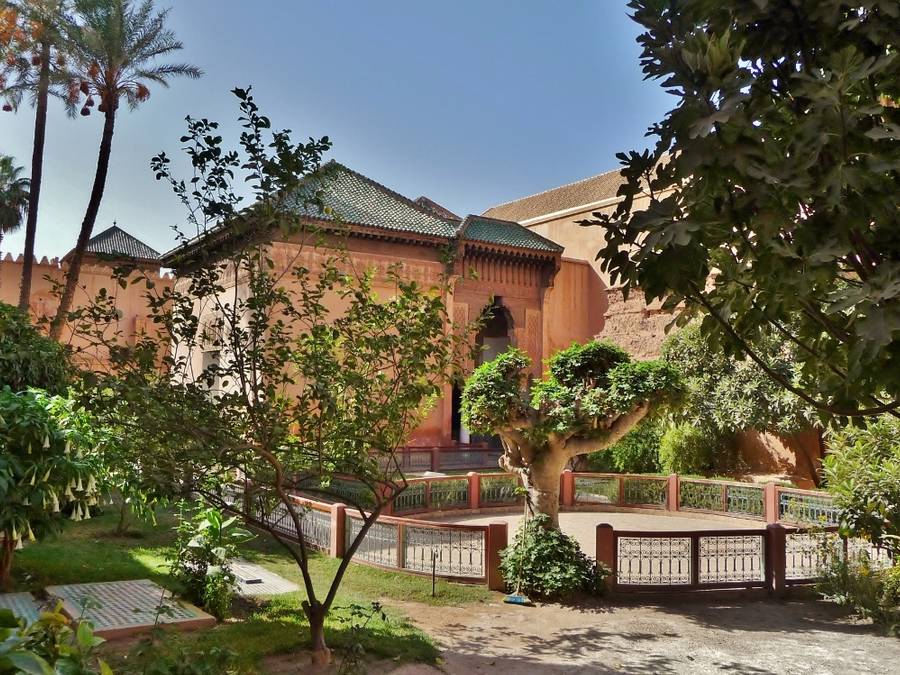
https://www.alksar.com/tombeaux-saadiens-marrakech/
A /Graves of the Kasbah in Marrakech | Treasure Resurfaced from the Past
The Saadian Tombs are a legacy of the eponymous dynasty that ruled the Kingdom of Morocco from 1511 to 1659.
They are located in the Kasbah district, near Bab Agnaou, and adjoining the magnificent Golden Apple Mosque known as El Mansour de la Kasbah, which has been recently renovated.
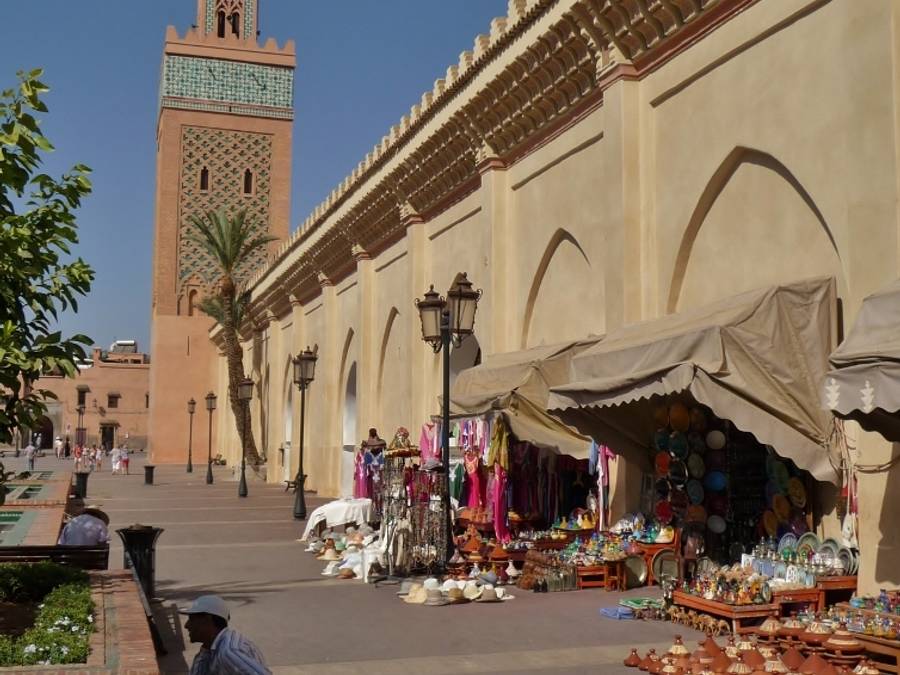
Les-tombeaux-Saadiens mosquée Kasbah Mosquee des 3 pommes d’or Bab AGnaou
The Royal Necropolis of several Saadian Princes and Sultans, from the 14th to the 16th century, the site also contains the graves of their family members, servants and soldiers.
It is only because of their divine character that the Saadian Tombs have been protected from the perils of time and history. For 2 centuries, the necropolis fell into oblivion while remaining walled.
It was only in 1917, during the French protectorate, that the Saadian Tombs were rediscovered following topographical surveys. The Saadian Dynasty has brought Marrakech and all of Morocco an exceptional heritage.
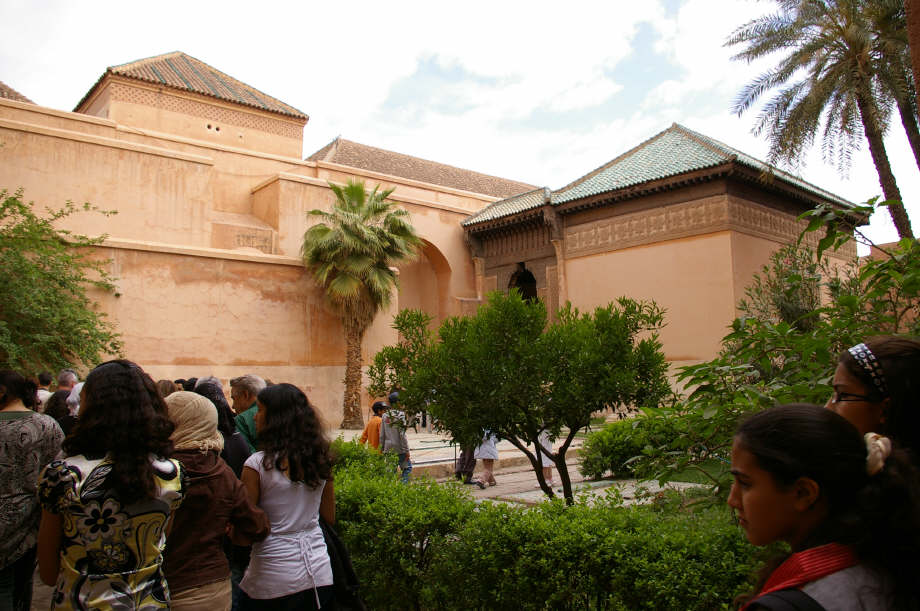
tombeaux-saadiens-marrakech-2
Discover the fabulous history of the Saadian Tombs, Wonder of Moorish Art, by immersing yourself in the epic of the Saadian Dynasty.
Discover the Places to Visit in Marrakech
B / The Incredible Saadian Heritage | Origin & History
The Saadian Dynasty, originally from Arabia, was established in 1511 with El Qaïm bi Amr Allah who carried out acts of holy war against the infidels : the Christians, in this case the Portuguese occupier, and in 1524 with the Capture of Marrakech under the rule of Ahmed al-Aarej (1517-1554).
The previous dynasty, that of the Wattassides, was indeed powerless to ensure peace and unity and to stop the Portuguese conquest.
Coming from a small village located in the Draa Valley, on the road to the Sahara dessert, 300km from Marrakech, the Saadian family is of Cherifian origin, i. e. descendant of God.
The power of the Saadians also comes from the popularity of their victories against the Portuguese, who had occupied part of Morocco for about 60 years. In 1541, Agadir was liberated from the Portuguese occupation by Mohammed al-Sheikh who became a hero and in 1550 only the cities of Tangier, Ceuta and Mazagan were still under Portuguese control. In 1554, Mohammed al-Sheikh again took over the city of Fez and reunited Morocco. Marrakech then became the capital of the Sultanate. The Saadians regain control of the caravan flow towards the Sahara.
Murdered, Mohammed al-Sheikh, who reigned from 1554 to 1557, left power to his son Moulay Abdallah al-Ghalib Billah (1557-1574), 4th of the line. A great builder, Al Ghalib had the Medersa Ben Youssef, Morocco’s largest coranic school, built in 1565.
It is also developing the drinking water supply network and building new buildings. He is redeveloping the Kasbah district. During his reign, his mother, Lalla Mesouada, had the Bab Doukkala Mosque built in 1557 and several Fondouks.
Traditionally, it is the brother of the deceased who should have taken over the succession, instead of the son. Several years of struggle between uncle and son followed. This dynastic war ended with the famous “War of the 3 Kings” or Battle of Wadi al-Makhazin, on August 4, 1578. Moulay Abdallah’s brother Abdallah al-Ghalib Billah, Abd-al-Malek, as well as Moulay Abdallah’s eldest son Mohammed al-Moutaoukil, and Portuguese king Dom Sebastien, died there.
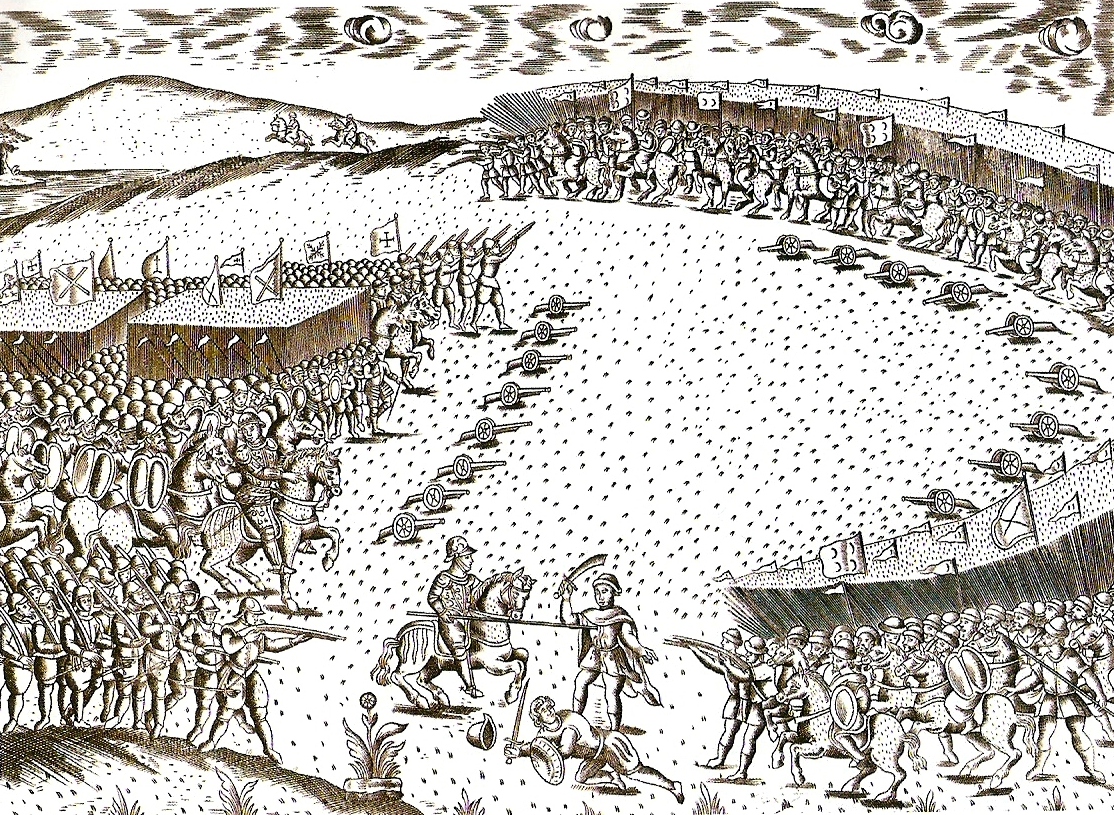
bataille des 3 rois
The Victory of the Saadians was on the Abu Abbas Ahmed throne, under the name of Sultan Ahmed al-Mansur (the victorious) (1578-1603). After a 20-year-old youth exile with his brother Abd-al-Malek because Moulay Abdallah al-Ghalib wanted to eliminate them to keep the throne. He is the 6th Saadian Sultan, brother of Abd El Malek and 5th son of Mohammed al-Sheikh.
This is followed by a period of great growth for Morocco and the capital, Marrakech. The ransom paid by Portugal to recover the thousands of Portuguese prisoners taken during the battle of the 3 kings, the gold from Sudan, which was conquered in 1590, as well as the sugar cane trade in the Marrakech region enrich the kingdom. This earned Ahmed Al Mansour the nickname “el Dehbi” (the golden one). Marrakech is equipped with magnificent buildings, such as the Badia Palace (the incomparable), built following the victory over the Portuguese.
Marrakech enjoys an important international reputation, commercially, diplomatically, especially in Europe, and militarily. Many ambassadors travel to Morocco. Sultan Al Mansour died of the plague in 1603.
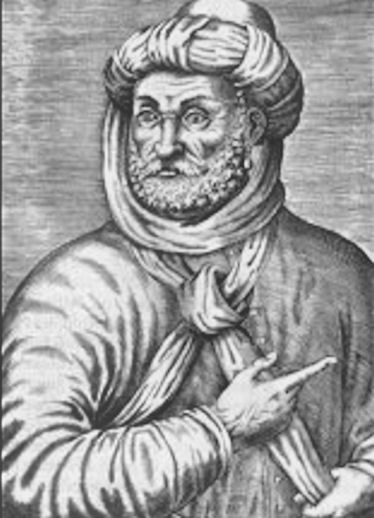
Ahmed_al_Mansur – 6e sultan saadien du maroc -1578 – 1603
Discover the History of Bahia Palace in Marrakech
C/ Genesis of the Saadian Tombs | Buried Persons
The site of the Saadian tombs is used as a necropolis since the 14th century, throughout the dynasty, it is embellished. The funeral site used since the 14th century will be flanked by a 1st mausoleum, in its centre, on the order of Moulay Abdallah al-Ghalib Billah in order to deposit the remains of Mohammed al-Sheikh, his father, murdered in 1557. The necropolis takes on a royal character following the burial of the 1st Saadian Prince Mohammed al-Sheikh.
In 1574, Sultan Abdallah el-Ghalib was also buried in the Koubba building.
The Archaeological Survey of Architect A Gilles in 1924 describes precisely the construction on the site of the Saadian tombs and the inscriptions on the stelae of the tombs.
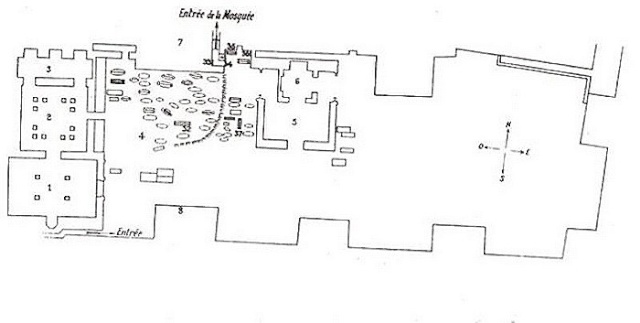
plan general tombeaux saadiens
Legend :
1 Mihrab Hall
2 Hall of the twelve columns
3 Room of the three niches
4 Cemetery
5 Second Koubba
6 Messaouda Hall
7 Great El-Mansour Mosque
8 Surrounding walls
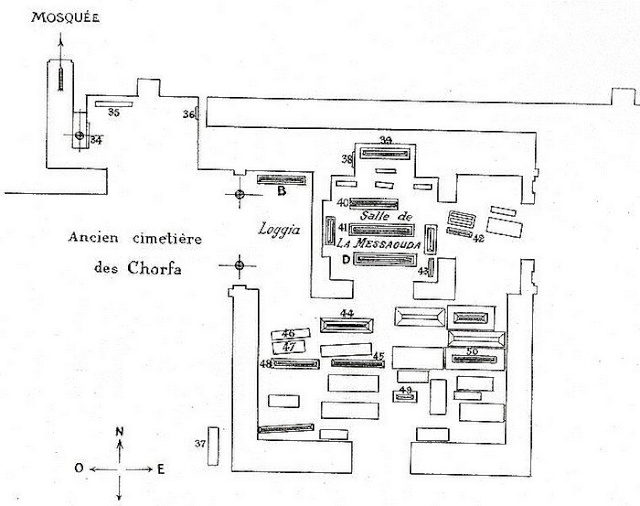
plan tombeaux saadiens koubba Lalla Messouda
Source http://www.cemaroc.com/t54-le-mausolee-des-princes-saadiens
39 The tomb of Lalla Mas’ouda, mother of Sultan Al Mansour
40 Tomb of Moulay Abdallah ben Mohammed, brother of Sultan Ahmed Al Mansour
41 The tomb of Abu Abdallah al-Sheikh, father of Sultan Ahmed Al Mansour
Ahmed El Mansour, 5th and youngest son of Mohammed al-Sheikh, had the place embellished in the Moorish Hispanic style and enlarged the whole by ordering the extension of the Koubba, named after his mother “Lalla Mesouada” (lalla meaning Madam). She was buried there at her death in 1591, in a sarcophagus made of carrara marble. This mausoleum is located in the centre of the courtyard.
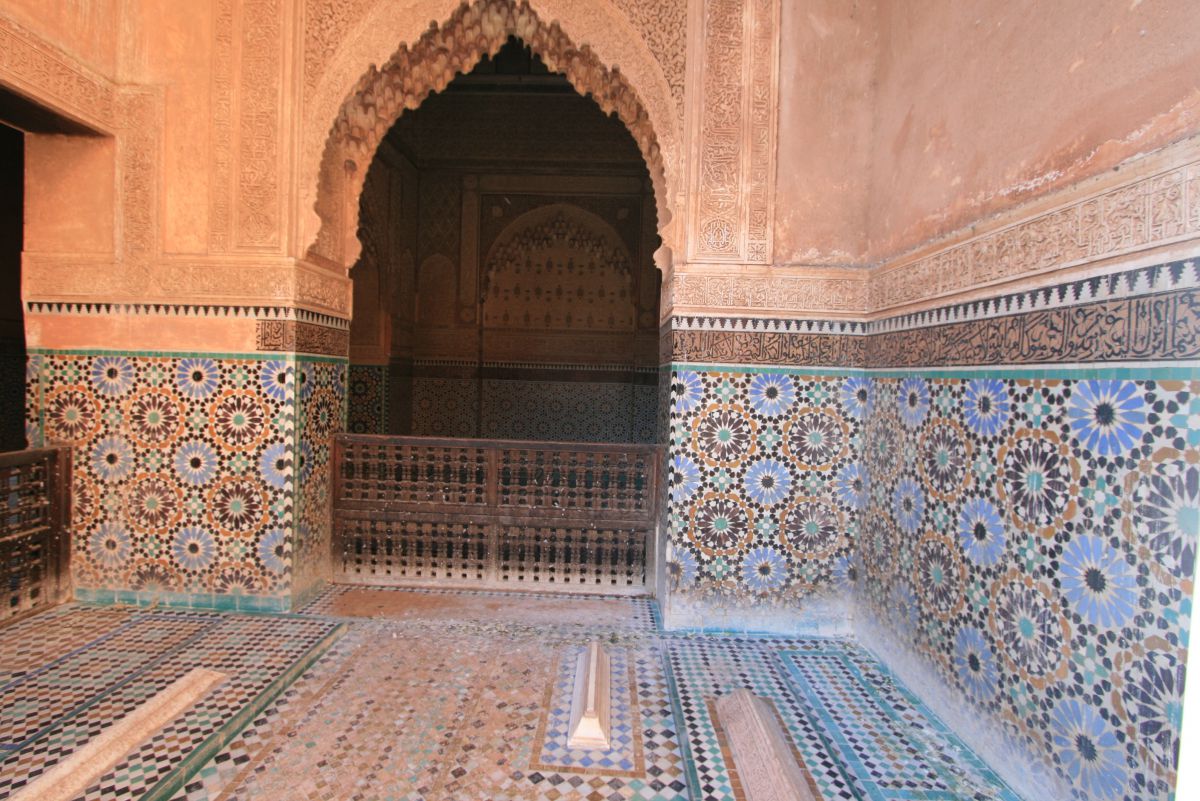
tombeaux_saadiens mausolée lalla mesouda
Died in 1603, Sultan Ahmed El Mansour rests in the central mausoleum, in the room of the 12 columns, surrounded by his son and grandson. Al Mansour had had this mausoleum built in order to have his own remains deposited there.
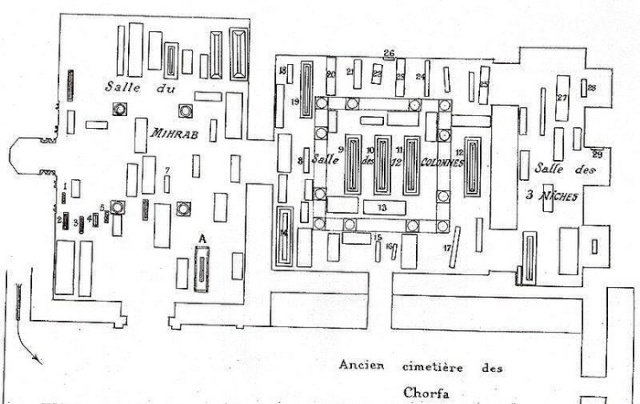
plan tombeaux saadiens
Source http://www.cemaroc.com/t54-le-mausolee-des-princes-saadiens
9 Tomb of Mohammed el-Cheikh ben Zîdane ben Ahmed el-Mansour ( ? 1064 ? -1653)
10 Tomb of Ahmed el-Mansour al Dahabi ( ?-1012 or ? – 1603)
11 Tomb of Zidane ben Ahmed El-Mansour ( ?- 1037 or ? – 1627)
Ahmed el-Mansour is surrounded by his Son Zidane and Little Son Mohamed (“Ben” = to be translated as “Son of”)
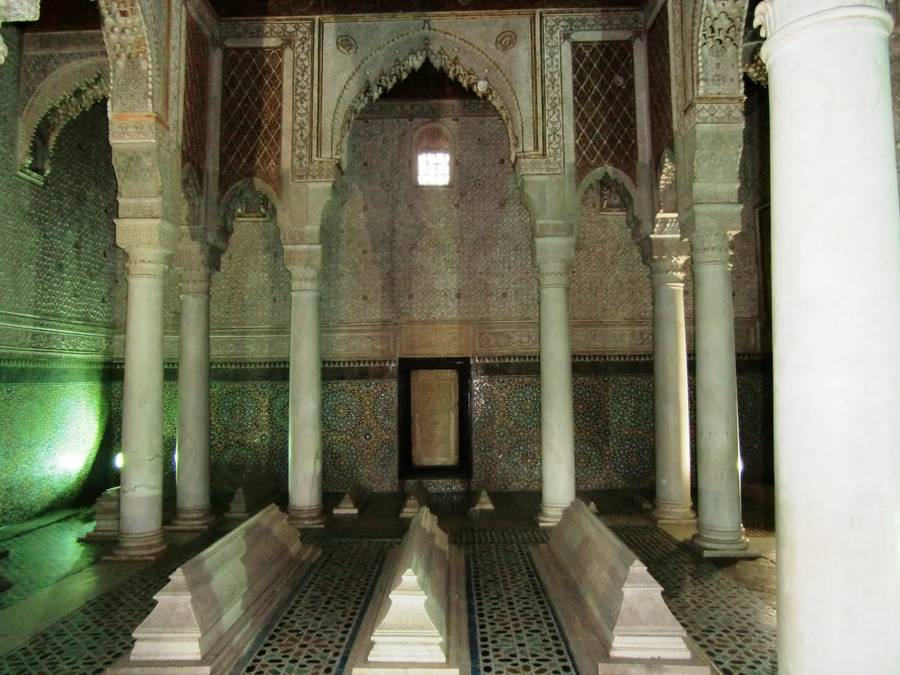
Saadians Tombs Marrakech
About sixty deceased Saadians, who lived 3 centuries ago in the el badi palace, are buried in the cimetary site.
Find Maps of Marrakech & South Morocco to Download & Print
D/ The Saadian Graves Halls | At the Kasbah
Mirhab Hall
At the entrance to the monument, there is a prayer room, called the Mihrab Hall, facing Mecca and containing an oratory. The 4 marble columns of the oratory divide it into 3 naves or funeral rooms.
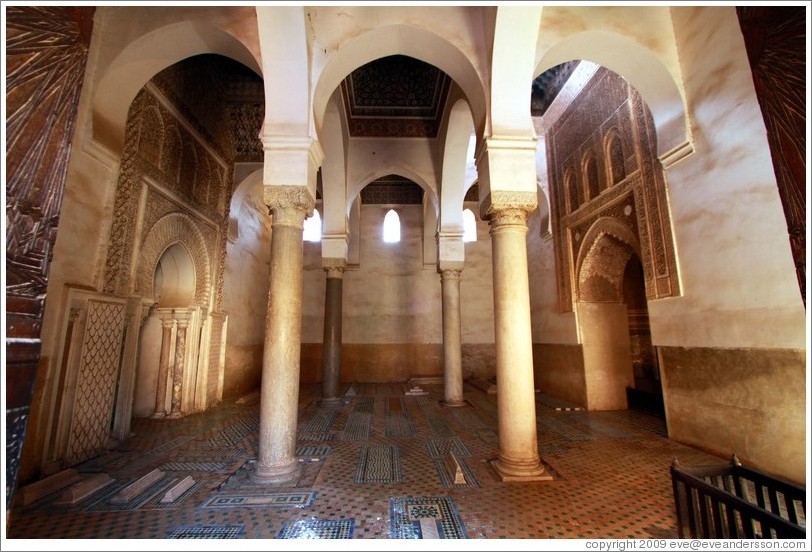
marrakech-medina-saadiens-tombs
Room of the 12 Columns
The central room contains the remains of Ahmed el Mansour. His grave is surrounded by that of his son Zidane and grandson Mohammed. This room, known as the 12 columns, is richly decorated:columns in carrara marble, decorated cedar ceiling, enamelled zelliges and carved plaster. The graves are also made of Carrara marble
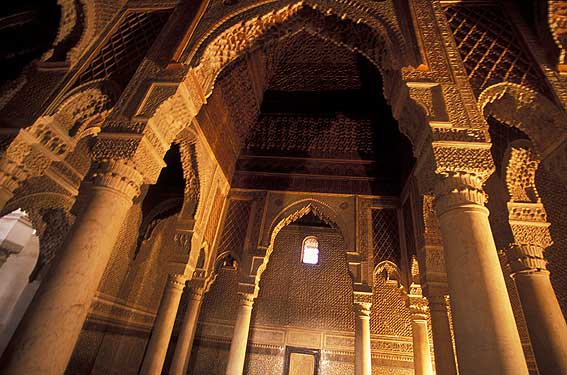
tombeaux-saadiens salle 12 colonnes
Room of the 3 niches (children’s graves)
The 3rd room, called the Princes’ Hall, on the right of the 12-column room, contains tombs of children and wives of the sultans.
The Second Mausoleum
The oldest mausoleum contains a white marble sarcophagus containing the remains of Ahmed el Mansour’s mother and the tomb of Mohammed El Sheikh, father of Ahmed Al Mansour
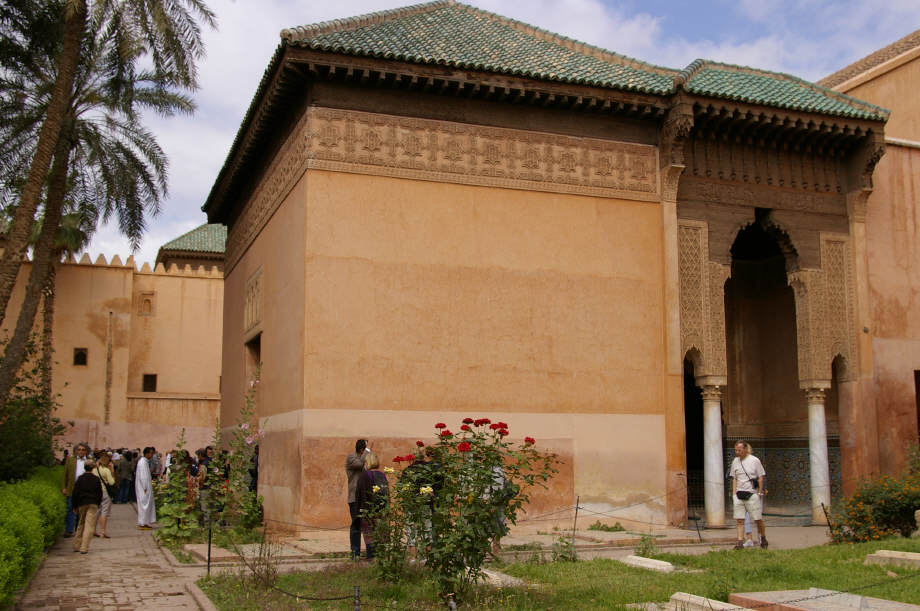
marrakech-saadiens-mausolée
The Funeral Garden
Servants and Soldiers are buried in the garden of the site.
About sixty tombs are visible on the ground, decorated with fes zeliges or carrara marble stone
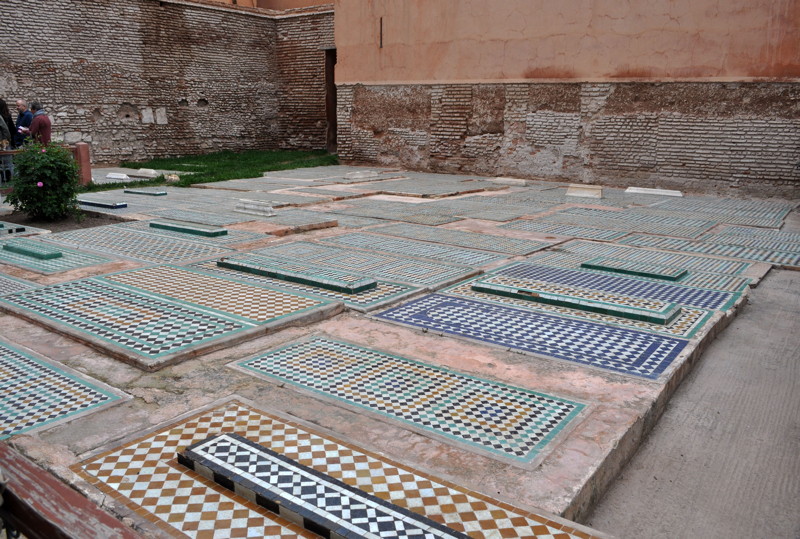
marrakech-saadiens
Access to the Site
Originally, access to the Tombs was only through a small passage to the nearby Mosque, but the French had a door drilled through the thick wall to allow non-Muslims to visit the site.
Visit Guesthouse Riad Al Ksar & Spa, former School in the Mellah of Marrakech
E/ Destruction of a Saadian Empire & Marrakchi
The Saadian Dynasty died out in 1659 following successional wars and the loss of the Sultanate’s unity. The descendants of Ahmed Al Mansour will be unable to prolong the greatness of the Saadian dynasty.
Moulay Ismail, of the Alawite dynasty, succeeded in taking power by reunifying the kingdom. Although he had the El Badi Palace destroyed, Moulay Ismail did not dare to destroy the Saadian necropolis. He will have the necropolis of the Saadian tombs walled up.
It was only in 1917, following the overflight of the site by a French army aircraft during topographical work, that the necropolis site was discovered.
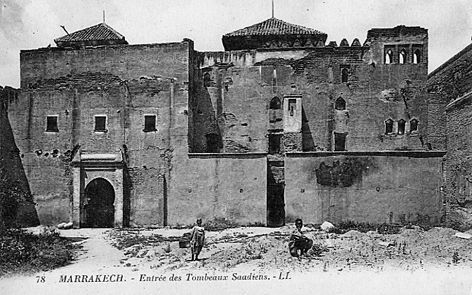
tombeaux saadiens ancienne photo
Restored by the Fine Arts and Historical Monuments Department, they will be permanently protected. The violence and vicissitudes of history will never completely erase the remains – a rich era for Marrakech and Morocco at the international level.
F/ Practical Information
Open every day from 9am to 4.30pm
Adult rates 70 dirhams per person (since August 2018).
Address: Kasbah district, behind the Kasbah Mosque.
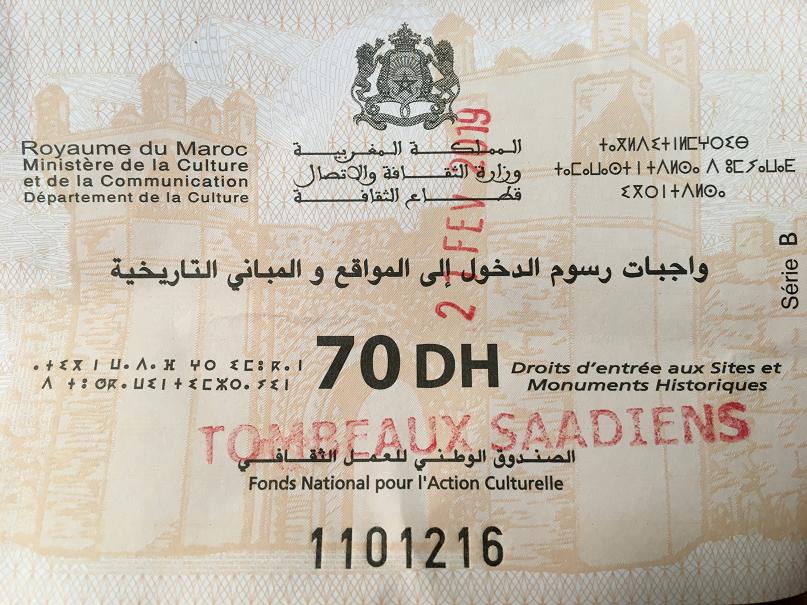
Tombeaux Saadiens Tarif Ticket Entree
The following Articles may interest you:
Yves Saint Laurent Museum Marrakech MYSLM
Monuments to Visit in Marrakech
Back to Blog Homepage
©alksar 2019 – https://www.alksar.com

